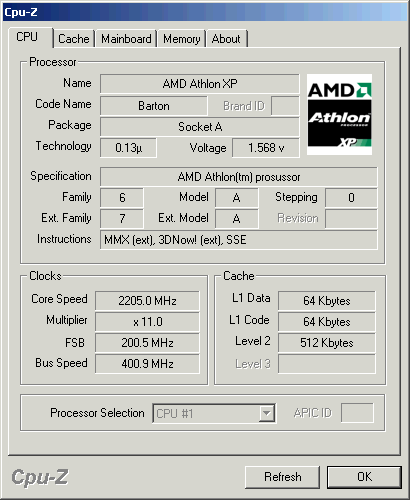AMDs Move To a 400MHz Bus Speed - What Can We Expect?
While AMD just recently increased the AthlonXP bus speed from 266MHz to 333MHz in October
2002, there has been a lot of talk lately about the AthlonXP moving to a 400MHz bus speed as early as the third quarter of 2003. As most overclockers already know, FSB (Front Side Bus) speed is very important to overall system performance. As we have seen in
the past with the Intel Celeron line of processors, a low FSB can severely limit the overall system performance of a processor regardless of what the CPU clock speed actually is.
|

|
| FSB |
Bus Speed |
| 100MHz |
200MHz |
| 133MHz |
266MHz |
| 166MHZ |
333MHz |
| 200MHz |
400MHz |
If you'll recall from past PCstats.com articles, the Front Side Bus (FSB) is the bus within a
processor that connects the CPU and memory. The faster this channel runs, the faster the processor can communicate with the motherboard and other components in the system. For example, the current crop of AthlonXP processors run with a 133MHz FSB, and in the case of AthlonXP 2700+'s and higher (including Barton), a 166MHz FSB.
Since the computers that support these processors are now exclusively employing DDR SDRAM (Double
Data Rate Synchronous DRAM), to get the bus speed, we double the FSB. Hence for a 166MHz FSB AthlonXP, the bus speed is 333MHz.
With this upcoming FSB change on the horizon
for AMD, many consumers will soon confront the eternal "should I buy now or wait" question. To illuminate
some of the potential differences, we're going to take a look forward and compare an AthlonXP
3000+ running at 333MHz bus speed to the same chip running at a 400MHz bus speed (while keeping CPU clock
speed approximately the same).
First though, I'm going to be a bit of a spoiler and ruin the suspense; overall system performance
at 400MHz bus speeds is better than that at 333MHz bus speeds - remember, higher bus speeds
can significantly help system performance.
Now
that we have that out of the way, let's discuss some of the pro's and con's of
moving to a higher FSB.

Please
disregard the reported voltage, CPU-Z does not read that
properly
Aside
from the higher performance
a 400MHz bus speed would bring to the table
for the AMD AthlonXP, it should also allow AMD to keep up with Intel in terms of
the speed crown; that is until AMD can officially release the Athlon64
processor in September 2003. The bump up also keeps AMD in the game as Intel is set to release their 800MHz FSB
version of the Pentium 4 processor, and marketing battles are set to flare
up.
While a
move to 400MHz bus speed sounds good and all, the only chipset on the market
that currently supports this nVIDIA's nForce2. Users who want to jump
on the 400MHz bus-speed-bandwagon will need to upgrade their older motherboards
to nForce2 based platforms to run their AGP/PCI's in sync. While it's true many
VIA KT400 and KT333 based motherboards can run at 400MHz without problems, most
videocards and PCI devices do not handle high AGP/PCI speeds well for a
prolonged period of time. Nforce2 mainboards such as the Asus A7N8X nForce2-SPP, MSI K7N2G-ILSR ,Epox 8RDA+, FIC AU11, and MSI K7N2-L all fall under that
envelope.

